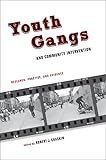Youth Gangs and Community Intervention : Research, Practice, and Evidence / ed. by Robert Chaskin.
Material type: TextPublisher: New York, NY : Columbia University Press, [2010]Copyright date: ©2010Description: 1 online resource (296 p.) : 5 tablesContent type:
TextPublisher: New York, NY : Columbia University Press, [2010]Copyright date: ©2010Description: 1 online resource (296 p.) : 5 tablesContent type: - 9780231146852
- 9780231519311
- 364.1/0660973 364.1066083 364.10660973
- HV6439.U5 Y68 2010
- HV6439.U5 Y68 2010
- online - DeGruyter
- Issued also in print.
| Item type | Current library | Call number | URL | Status | Notes | Barcode | |
|---|---|---|---|---|---|---|---|
 eBook
eBook
|
Biblioteca "Angelicum" Pont. Univ. S.Tommaso d'Aquino Nuvola online | online - DeGruyter (Browse shelf(Opens below)) | Online access | Not for loan (Accesso limitato) | Accesso per gli utenti autorizzati / Access for authorized users | (dgr)9780231519311 |
Frontmatter -- Contents -- Acknowledgments -- Introduction -- Part I. Framing the Youth Gang Problem -- 1. The Chicago School: A Context for Youth Intervention Research and Development -- 2. The Evolution of Gang Policy: Balancing Intervention and Suppression -- Part II. Evidence, Evaluation, and Knowledge Utilization -- 3. Lessons Learned from Gang Program Evaluations: Prevention, Intervention, Suppression, and Comprehensive Community Approaches -- 4. An Examination of the Role of CeaseFire, the Chicago Police, Project Safe Neighborhoods, and Displacement in the Reduction in Homicide in Chicago in 2004 -- 5. From Knowledge to Response and Back Again: Theory and Evaluation in Responding to Gangs -- 6. Promoting Research Integrity in Community-Based Intervention Research -- Part III. (Re)considering Contexts, Orientations, and Interventions -- 7. Multiple Marginality and Human Development: Applying Research Insights for Gang Prevention and Intervention -- 8. A Community Youth Development Approach to Gang Control Programs -- 9. Taking Criminology Seriously: Narratives, Norms, Networks, and Common Ground -- 10. Community Gang Programs: Theory, Models, and Effectiveness -- Contributors -- Index
restricted access online access with authorization star
http://purl.org/coar/access_right/c_16ec
Although a range of program and policy responses to youth gangs exist, most are largely based on suppression, implemented by the police or other criminal justice agencies. Less attention and fewer resources have been directed to prevention and intervention strategies that draw on the participation of community organizations, schools, and social service agencies in the neighborhoods in which gangs operate. Also underemphasized is the importance of integrating such approaches at the local level. In this volume, leading researchers discuss effective intervention among youth gangs, focusing on the ideas behind, approaches to, and evidence about the effectiveness of community-based, youth gang interventions. Treating community as a crucial unit of analysis and action, these essays reorient our understanding of gangs and the measures undertaken to defeat them. They emphasize the importance of community, both as a context that shapes opportunity and as a resource that promotes positive youth engagement. Covering key themes and debates, this book explores the role of social capital and collective efficacy in informing youth gang intervention and evaluation, the importance of focusing on youth development within the context of community opportunities and pressures, and the possibilities of better linking research, policy, and practice when responding to youth gangs, among other critical issues.
Issued also in print.
Mode of access: Internet via World Wide Web.
In English.
Description based on online resource; title from PDF title page (publisher's Web site, viewed 02. Mrz 2022)


